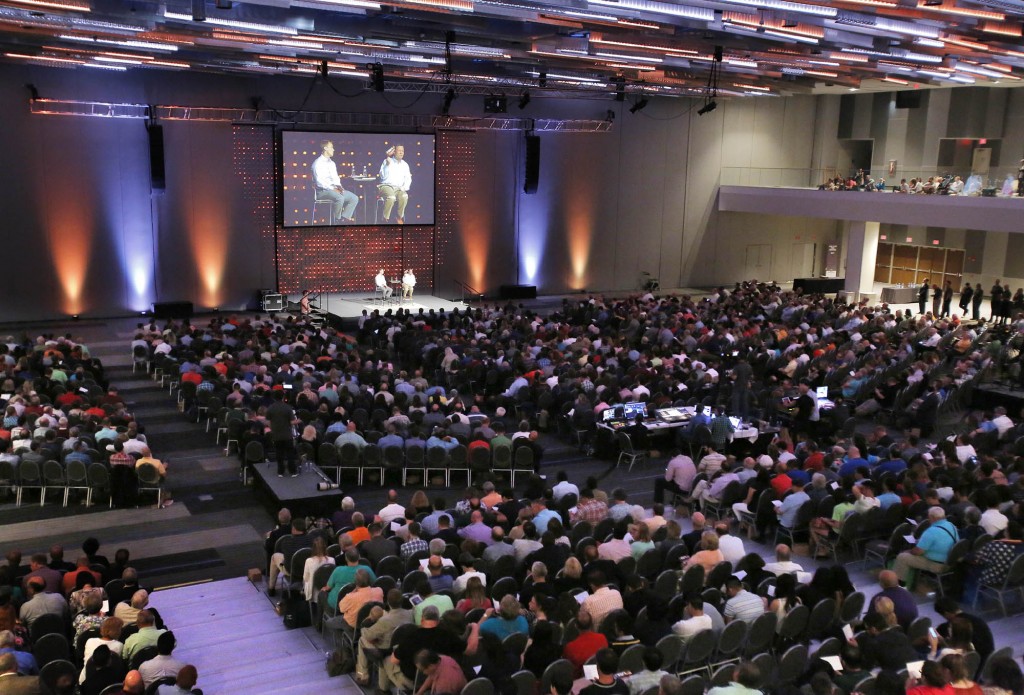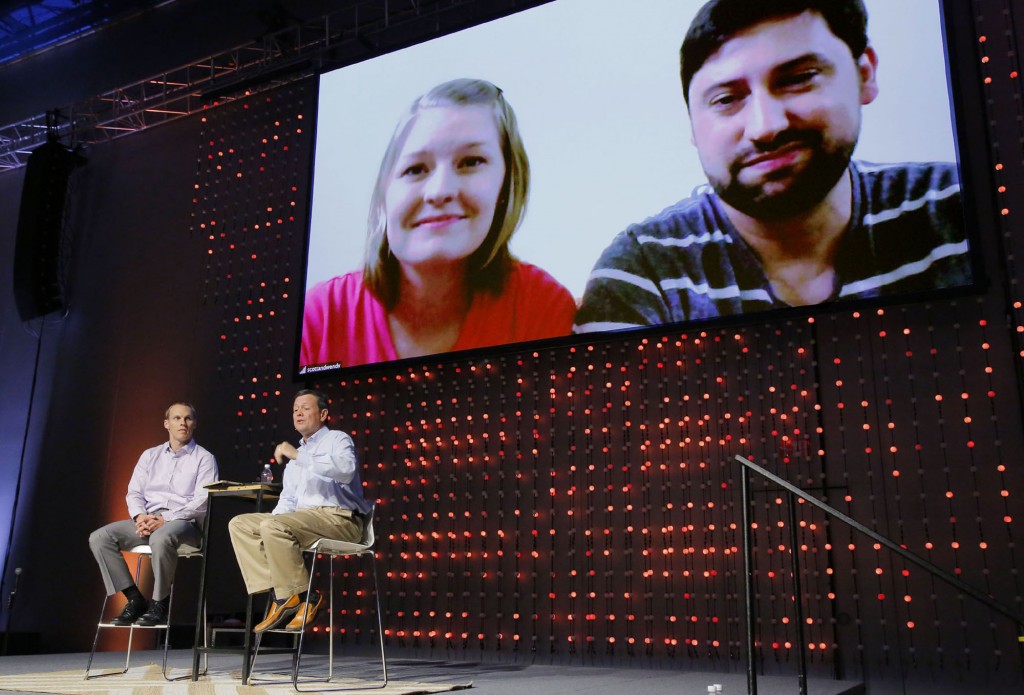by Joe Conway
COLUMBUS, Ohio (BP) — “What if?” That was the question posed to more than 2,600 attendees of the June 15 Send North America Luncheon at the SBC Pastors’ Conference in the Greater Columbus Convention Center, host to the annual meeting of the Southern Baptist Convention. The event promised a glimpse into the future of missions in the SBC from the presidents of the International Mission Board and North American Mission Board.
NAMB President Kevin Ezell began the live portion of the event with the same question.
“What if we looked for every possible way to partner together to equip the church in North America for missions?” Ezell said. “What if we equipped every pastor to lead his people to live lives on mission?”
Ezell said NAMB has streamlined to advance the Send North America strategy to assist every church in finding its next step in missions — both across the continent and through 32 strategic Send North America cities.
“I am excited about what God is doing through the church in North America,” said David Platt, president of IMB, who co-sponsored the event. Platt said he believed it unwise both practically and biblically to pursue a top-down strategy of missions.
“The local church is the center of missions,” he said. “When you look at the Book of Acts, you don’t see NAMB or IMB anywhere, but you do see churches.”
Platt shared IMB’s concept of limitless mission teams which combine traditional, fully funded missionaries; professionals who move to an area to both work in a secular job and serve with the team; retirees who intentionally use their status to serve on a team; and students who strategically select their universities and commit to serving with the teams.
“We have 4,700 missionaries who are challenged in serving in some of the hardest and darkest places on the planet,” Platt said. “But there are 6,000-plus unreached people groups. In its history, IMB has funded 26,000 missionaries. I am thankful for their service. But we need 26,000 missionaries now.”
Facing reality, Platt said the IMB missionary force will likely drop in the coming year because of last year’s $21 million budget shortfall.
“We have to think in different ways,” Platt said. “We don’t need 100 more missionaries, we need 1,000 more. Our mission demands more. God is opening up opportunities for us with the globalization of the marketplace. We have to recognize those opportunities. When we think of global missions, we have to know that everyone has a part to play. The IMB has a part in that.”

More than 2,600 guests joined hosts Kevin Ezell and David Platt to hear the men discuss the future of missions in the Southern Baptist Convention (SBC) at the Send North America Luncheon during the Pastors’ Conference at the Greater Columbus Convention Center, host to the annual meeting of the SBC. Ezell, president of the North American Mission Board, and Platt, president of the International Mission Board, said they are committed to exploring further cooperation between the entities when and where it makes sense to do so. Photo by John Swain/NAMB
Effective, efficient systems
Ezell asked Platt about his first nine months at the helm of IMB and where he finds himself today with potential changes.
“Everything is on the table,” Platt said. “We are exploring the most effective and efficient systems to get the Gospel to the nations. But we must be deliberate in what we do.”
The move to a more simplified leadership structure at IMB was one change that made sense, Platt said. Policy changes to advance the creation of limitless missionary teams also made sense, he said. He emphasized that IMB’s board of trustees is in no way diminishing its commitment to the sound doctrinal and theological principals that have made the entity trustworthy, but rather is aligning policies with the Baptist Faith and Message.
The mission board presidents also discussed ways the entities can cooperate to benefit God’s kingdom and Southern Baptists in advancing God’s mission.
“We are working as closely together as we can,” Ezell said. “There are aspects of missions and church planting that are different in North America and overseas, but there are also commonalities in church planting. We can rely on each other’s expertise. People need to be comfortable with us exploring ways to advance missions.”
One of those possibilities is a combined registration process for missionary candidates, Ezell noted. Platt added having competing systems “makes no sense.” NAMB also provides scholarships for church planters to take vision trips to connect with people groups overseas for possible adoption.
Another area of cooperation is the Send North America Conference the entities will host Aug. 3-4 in Nashville. Earlier in the presentation, Ezell invited participants to commit to the event.
“What if we held a missions conference to celebrate what we can do together and explore the mission of God?” Ezell asked. He told the gathering the initial goal for 2012’s first Send Conference was 1,000 people; 2,200 attended. In 2013, more than 4,400 participated. Paid registration for the 2015 conference is above 12,000. Only 1,500 seats remain. The Send Conference is designed to help churches find their next steps in missions, regardless of their level of engagement.

International Mission Board (IMB) President David Platt (seated, far left) and North American Mission Board President Kevin Ezell visit with IMB missionaries Scott and Wendy via Skype during the Send North America Luncheon at the Southern Baptist Convention Pastors’ Conference. Scott and Wendy serve in a South Asian megacity working to evangelize an unreached people group. The couple received their letter of acceptance Monday to adopt a 3-month-old boy. Photo by John Swain/NAMB
The luncheon also included a Skype session with the two presidents and two Christian workers serving in South Asia. The couple has seen 25 people accept Jesus as Savior.
“We are working among an unreached people group,” one of the workers said. “We give the churches tools for multiplication. Seeing them catch the vision is exciting.”
The couple met in seminary and married before serving on mission in South Asia. They had been unable to have children, a journey that led them to commit to adoption. They received a letter of acceptance for a three-month old child with special needs from another country Monday. And, six months ago, they welcomed the birth of their first son.
Before Platt concluded the interview with a prayer, he informed the couple that the SBC Minister’s Adoption Fund, founded by Ezell when he was president of the Pastors’ Conference in 2010, will pay the remainder of their adoption expenses, about $10,000.
In closing, Ezell thanked Southern Baptists for their support of the Cooperative Program, the Annie Armstrong Easter Offering and the Lottie Moon Christmas Offering. Platt reiterated the importance of the convention’s mission focus.
“It is not tolerable that 2 billion people have not heard the name of Jesus,” Platt said. “We must tell them.”
For more information about IMB, visit www.imb.org/send. Learn more about NAMB at www.namb.net/mobilize-me.







